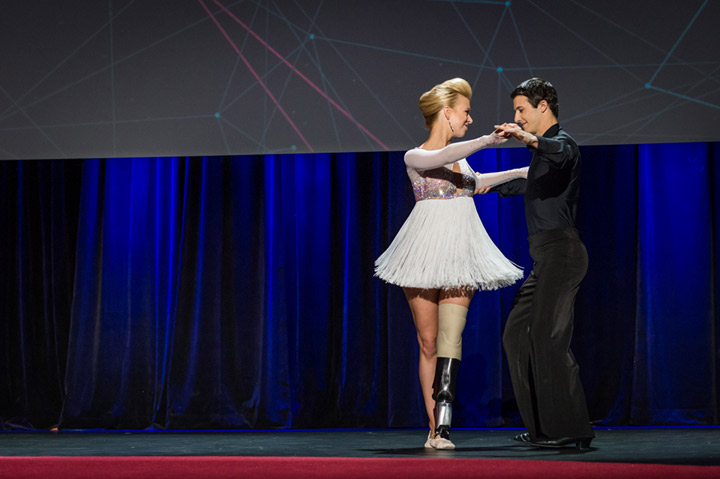TORONTO – Boston Marathon survivor Adrianne Haslet-Davis took a big step on her road to recovery on the TED Talks Vancouver stage Wednesday night – many steps to be exact.

The professional ballroom dancer and instructor took to the stage to perform a short rumba to the tune of Enrique Iglesias’ “Ring My Bells.” It was the first time she had danced publicly since losing her lower left leg in the April 2013 bombing.
Supporting Haslet-Davis was a custom designed bionic leg built to help her move just as she did before.
The performance was done as part of a TED Talk by Hugh Herr, director of the Biomechatronics Group at the MIT Media Lab, in which he discussed the field of prosthetics and his vision for the future of bionic limbs that would allow full rehabilitation of patients.
Herr teamed up with Haslet-Davis after meeting her at a rehabilitation hospital and hearing her story.
His lab participated in over 200 days of research to understand the dynamics of dance – they studied how dancers move and where force is applied to the limbs as they create different movements.
They then took that research and used it to build Haslet-Davis a bionic leg.
“In 3.5 seconds, the criminals and cowards took Adrianne off the dance floor,” he said during the talk Wednesday. “In 200 days, we put her back.”
According to the TED Talks blog, the Center for Extreme Bionics at the MIT Media lab is where Herr and his team study the science and technology that allows the “repair of humans across a broad range of brain and body issues.”
The team has a large focus on bionic limbs.
Herr, a double amputee who uses prosthetic legs to walk, also discussed how his lab uses precise science to attach the limbs and how they use electricity to make prosthetics that move like flesh and bone.
“I imagine a future so advanced that we could rid the world of disability—in which neuroimplants allowed the blind to see, in which the paralyzed could walk with exoskeletons,” he said.
“We need to do a better job in bionics to allow full rehabilitation.”
The team studies how people walk and run to get a full understanding of what the muscles are doing and how they are being controlled by the brain. This helps them to create limbs that move more naturally.
READ MORE: TED Talks Vancouver brings some of tech’s brightest minds to Canada
“On heel strike, the system modulates stiffness and then lifts the person into walking stride just like the muscles in the calf region,” read the TED blog post detailing Herr’s work.
“These bionics allow wearers to walk up stairs easily, even run up steep inclines.”
According to the blog, Herr’s team is also working on “exoskeleton-like devices” that users could wear in the future to protect their limbs during physical activities like running – including a version made for people who aren’t missing limbs, which would help apply torque and power to the user’s movements.
”We’re beginning the age in which machines attached to our bodies will make us stronger and more efficient,” said Herr.
Haslet-Davis previously appeared on a Dancing With the Stars segment where she accepted an invitation to dance on the show once further along in her recovery. She is said to be making an appearance on the show sometime this season.






Comments